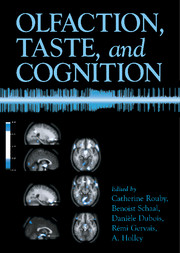Book contents
- Frontmatter
- Contents
- Contributors
- Preface
- Acknowledgments
- A Tribute to Edmond Roudnitska
- OLFACTION, TASTE, AND COGNITION
- Section 1 A Specific Type of Cognition
- Section 2 Knowledge and Languages
- 4 Names and Categories for Odors: The Veridical Label
- 5 Nose-wise: Olfactory Metaphors in Mind
- 6 Linguistic Expressions for Odors in French
- 7 Classification of Odors and Structure–Odor Relationships
- Section 3 Emotion
- Section 4 Memory
- Section 5 Neural Bases
- Section 6 Individual Variations
- Index
- References
7 - Classification of Odors and Structure–Odor Relationships
Published online by Cambridge University Press: 21 September 2009
- Frontmatter
- Contents
- Contributors
- Preface
- Acknowledgments
- A Tribute to Edmond Roudnitska
- OLFACTION, TASTE, AND COGNITION
- Section 1 A Specific Type of Cognition
- Section 2 Knowledge and Languages
- 4 Names and Categories for Odors: The Veridical Label
- 5 Nose-wise: Olfactory Metaphors in Mind
- 6 Linguistic Expressions for Odors in French
- 7 Classification of Odors and Structure–Odor Relationships
- Section 3 Emotion
- Section 4 Memory
- Section 5 Neural Bases
- Section 6 Individual Variations
- Index
- References
Summary
In spite of considerable recent progress in olfaction studies, the sense of smell remains poorly understood, and the description of perceived odors is still a difficult task. When our understanding of olfaction is compared with that for other senses, such as vision, there are striking differences: In the field of vision, the absorption spectra of electromagnetic radiation are easily measured and provide information to predict the perceived colors of substances. As the molecular features responsible for the characteristics of light absorption are well known, the colors of substances, such as dyes, can be predicted with reasonable accuracy. The situation is much more obscure for the olfactory properties of substances, as in olfaction there is no equivalent for absorption spectra, and descriptions of odors, which are absolutely necessary to establish structure–odor relationships, have been far from rigorous.
To describe an odor, we generally search through our past experience to try to make comparisons with similar chemical compounds encountered earlier, attempting to find appropriate words. However, even if we decide that compound A smells somewhat like compound B, but does not smell exactly the same, we nevertheless feel justified in using the same words to describe both. Moreover, unless we are carefully trained experts, there will be emotional, personal, and cultural factors that will intervene in our perceptions and strongly influence our choices of descriptors. Concern about such factors was long ago expressed by the Dutch physiologist Zwaardemaker (1899), who called for a quantitative psychology of olfaction.
Information
- Type
- Chapter
- Information
- Olfaction, Taste, and Cognition , pp. 100 - 116Publisher: Cambridge University PressPrint publication year: 2002
References
Accessibility standard: Unknown
Why this information is here
This section outlines the accessibility features of this content - including support for screen readers, full keyboard navigation and high-contrast display options. This may not be relevant for you.Accessibility Information
- 30
- Cited by
